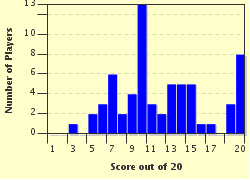Quiz Answer Key and Fun Facts
1. Where was the Enterprise on December 7th, 1941?
2. At the outbreak of war for America, how many other US Navy carriers were in the Pacific along with Enterprise?
3. Enterprise was a Yorktown class carrier. Obviously, she had a sister named Yorktown. How many Yorktown class carriers served during WWII?
4. When USS Hornet traversed the Panama Canal, she headed to Alameda California to take on US Army aircraft for Doolittle's Tokyo Raid. She would rendezvous with Enterprise, which would provide air cover and strike potential, since Hornet's decks were covered with 16 twin engine bombers, too large to store in the hanger deck. What kind of bombers did Enterprise protect until launched near Japan?
5. After the Doolittle Raid and the Battle of the Coral Sea, code breakers determined the next Japanese objective was Midway. Enterprise and Hornet with Task Force 16 were to report northeast of Midway and await the partially repaired Yorktown and Task Force 17. What name was given for the rendezvous location?
6. At the battle of Midway, US Dauntless dive bombers were launched for an attack against the Japanese carriers. They never linked up with torpedo or fighter planes for the coordinated attack one might have expected from a multi-carrier strike force. Running low on fuel and about to turn back, what did the bombers see that showed them the way to the enemy carrier fleet?
7. The IJN Hiryu quickly launched an attack, following the US aircraft back to their carriers. They attacked, scoring three bomb hits. They left the USS Yorktown burning and dead in the water. Did the Japanese think the odds were even, giving them hope they might yet sink the last of the still active US carriers?
8. After Midway, the surviving US carriers replaced their Douglas TBD Devastator torpedo planes with Grumman TBF Avengers. Five Devastators were lined up at Pearl Harbor's Ford Island. One each from Yorktown and Hornet, three from Enterprise. These were the five survivors from over forty on board the three carriers. What did one of the Enterprise planes have in common with the two planes from Hornet and Yorktown?
9. After the Battle of Midway, the Enterprise was trying to prevent Japanese forces from assaulting a long contested island with a critical airfield. She took three bomb hits helping to defend what island?
10. With USS Wasp sunk and USS Saratoga again damaged and in dry dock, only Enterprise and Hornet were present for which battle that left Enterprise the lone functioning US carrier in the Pacific?
11. After Guadalcanal was secure, Enterprise was well to the south when a B-17 reported a Japanese carrier task force approaching Guadalcanal, about 250 miles northeast. Out of range, Enterprise's Air Group Ten launched, intending to refuel at Henderson field on Guadalcanal. From there they would reform and engage the enemy. Once reformed, the enemy never was found. Why was this?
12. Enterprise returned to the mainland for a thorough refit. Which city's base had the honor of upgrading the last of the Yorktown class?
13. By the time Enterprise returned to duty, she had five new fleet carriers in the Pacific with her. Two were named after the lost carriers Lexington and Yorktown, and another soon to be launched would be named for the Hornet. What class were these new fleet carriers?
14. Enterprise had trouble with Japanese land-based twin engine Betty bombers conducting attacks at night. The only aircraft on Enterprise equipped with radar were the TBF Avengers, not designed for air to air combat. How did Enterprise improvise?
15. Enterprise's next target was thought of as "The Gibraltar of the Pacific". What Japanese base was this?
16. Enterprise and her big and little sister carriers struck Japanese bases at Saipan and Guam, part of the Mariana Island group. It later developed into the largest carrier vs. carrier battle in history. Due to factors including inexperienced pilots and older equipment, the Japanese suffered horrible loses of both seaborne and land based aircraft. What completes this battle's name? "The Great Marianas __________"
17. After the Marianas engagement, hundreds of aircraft were returning to Enterprise and her sisters in task force 58. It was completely dark and nighttime carrier landings were rare at this point in history. Which admiral gave the order to turn on every carrier's running lights?
18. The Battle of Leyte Gulf had the remainder of the Japanese navy try to smash the landing beaches and supply ships involved in the US return to the Philippines. They were divided into three forces. The Northern (decoy) force consisted of nearly unarmed carriers and escorts. The Central Force had the two super battleships Yamato and Musashi with several other battleships and numerous cruisers and destroyers. The Southern Force had two older battleships with a few destroyers and a cruiser. The two battleship forces were to form a pincer attack if and when the US fleet was drawn away by the Northern Force. What did Enterprise's aircraft do that no other US force did in the battle?
19. The Enterprise (CV6) becomes the only WWII carrier to have N added to her hull classification symbol making her CV(N)6. In this case, what does the N in CV(N)6 stand for?
20. Having won twenty Battle Stars, sinking seventy-one ships, and destroying 911 enemy aircraft, the USS Enterprise suffered an undeserved fate. After the war, what happened to "The Grey Ghost"?
Source: Author
pointluck
This quiz was reviewed by FunTrivia editor
bloomsby before going online.
Any errors found in FunTrivia content are routinely corrected through our feedback system.


